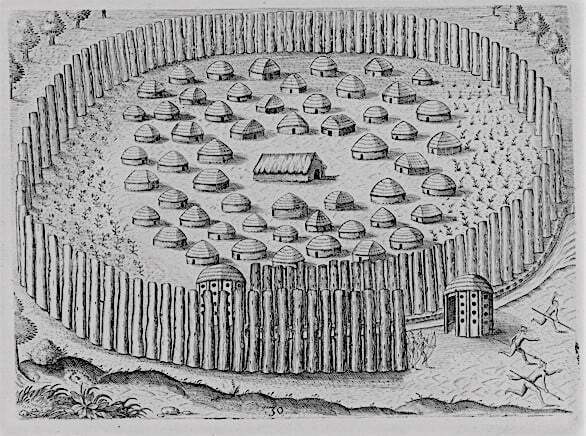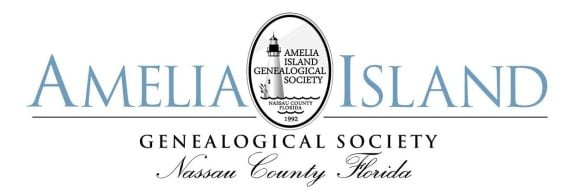August General Meeting Highlights

I want to personally thank Prof. Keith Ashley for an outstanding presentation about the ongoing archaeological excavations on Big Talbot Island. If you were unable to attend our first in-person meeting since Covid_19, then you also missed one of the best speakers we’ve been able to schedule! If your perception of what a Timucuan village looked like back in the 16th Century is tied to Theodore de Bry’s engraving, pictured here, then you have been deceived. The excavation is showing that the depiction is largely the fanciful artistry of de Bry, where he reused features found in other tribal villages and applied it to whatever tribe he was engraving at the time. History shows us that tribes were distinct and reliant on the resources around them. Their utensils, tools, food, and homes were all dependent on the resources available. The findings at Mocama are based on three themes described by Prof. Ashley:
- Hereditary Leaders
- Ranked Clans
- Social Inequality
Mocama is not the only dig Prof. Ashley is leading, we hope to have him back in 2022 to discuss the findings from the other excavation!
July General Meeting Highlights
I missed commenting about our virtual meeting held in July as I was still working on a personal family writeup, the fruition of that presentation. As we did in June, we featured a video lecture from Prof. John Philip Colletta, part of the genealogy DVD series by The Great Courses called Discovering your roots : an introduction to genealogy. If you missed the meeting you can still check the DVDs out from the Fernandina Branch of the Nassau County Library.
In Prof. Colletta’s lecture on “How to write biography”, we were provided a process for constructing and narrating the biography of an ancestor. Briefly the steps were:
- Create a Timeline
Create a Timeline of your Ancestors life events. - Build historical context (we were shown how in June’s General Meeting)
Build historical context around each of the events of the timeline. - Identify a Theme
Scrutinize the timeline to see whether there is a pervasive theme or a central conflict that typifies their life. - Write a Life Story
When writing a life story you can choose any number of literary formats: chronological order, in medias res – starting in the middle of their life, or a statistical summary (traditional genealogical format). - Review the Life Story
It’s always wise to have some other individual review your biography and give you suggestions and corrections.
I mentioned in the short outlude after the lecture that I would write a life story using the technique shown in the video lecture. The fruition of this is an article I posted on my personal genealogy blog, Genealogy of Dennis Partridge. The life story is on a couple, not a single ancestor, Vincent Croteau and Jeanne Godequin. Here’s how I approached each of the five steps above:
- A timeline was the easy part for me, since I use a FamilyTreeMaker I was able to create the timeline for Vincent Croteau and a timeline for Jeanne Godequin.
- I built historical context around several of the events in the life of both Vincent and Jeanne, most notably their births in France, and their marriage in Quebec.
- It was obvious as I studied the timeline that the overriding theme was the planning that Vincent and Jeanne did as they raised their family together. While not always a smooth rise, the notarized documents provide a glimpse of the social status of Vincent and Jeanne, as they rose from servants to habitants to censitaires.
- I chose a combination of the three ways to write a life story. I started with their births, then their marriage, then I provided a discussion of the notarized documents in order, ending with the genealogical representation of their family. Yep, I realize now, I forgot their deaths… I’ll leave that for another day.
- Who would I choose to review this life story? Why you of course. Please let me know your thoughts, comments, and criticisms… If you attended the July virtual meeting, can you identify the various tips that Prof. Colletta mentioned and I utilized in the writing of this story?
Cemetery Committee
We are still in search for a head of the Cemetery Committee. We cannot get this committee truly active again without somebody leading it. In the meantime, Jim Miller and I, surveyed and documented three cemeteries which are on Rayonier property in August. I appreciate Rayonier’s cooperation and participation in this project! Hopefully we can get these cemetery listings and photos up on the website over the next month.
Library Committee
The library committee held their September meeting early this year. The fruition of this meeting and their work can be found in their minutes which will be uploaded to the website once finalized.
We received two donations of genealogical books this month comprising 37 additional volumes added to our AIGS Research Collection at the Fernandina Beach Library. Thanks to both Anita Lay and Jim Miller for their generous contributions! Click this link to see the full list of 2021 Library Contributions.
